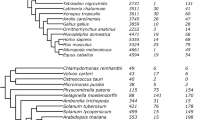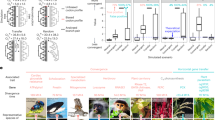Abstract
As a protein-encoding gene evolves, different selective pressures act on the gene temporally and spatially. An examination of the ratio of nonsynonymous-to-synonymous nucleotide substitution rate ratios (Ka/Ks) has proven to be a valuable method to examine selective pressures on protein encoding genes, including detecting positive diversifying selection. To gain power over averaging all sites in a gene together, examination of sites in primary sequence windows has frequently been employed. However, selection acts on folded proteins and sites that are close in tertiary space may not be close in primary sequence. A new method for the examination of Ka/Ks ratios based upon windows in tertiary structure is introduced and applied to the leptin gene family in mammals. Tertiary sequence windowing detects new sites under positive diversifying selection and detects positive diversifying selection with a more significant signal along various branches of the leptin gene family tree.


Similar content being viewed by others
References
Y Benjamini Y Hochberg (1995) ArticleTitleControlling the false discovery rate: a practical and powerful approach to multiple testing J Roy Stat Soc B 57 289–300
SA Benner N Trabesinger-Rueff DR Schreiber (1998) ArticleTitleExobiology and post-genomic science. Converting primary structure into physiological function Adv Enzyme Reg 38 155–180 Occurrence Handle10.1016/S0065-2571(97)00019-8 Occurrence Handle1:CAS:528:DyaK1MXnt1Chtrg%3D
SA Benner MD Caraco JM Thomson EA Gaucher (2002) ArticleTitlePlanetary biology: paleontological, geological, and molecular histories of life Science 296 864–868 Occurrence Handle10.1126/science.1069863 Occurrence Handle1:CAS:528:DC%2BD38XjsFOrs7Y%3D Occurrence Handle11988562
HW Berman J Westbrook Z Feng G Gilliland TN Bhat H Weissig IN Shindyalov PE Bourne (2000) ArticleTitleThe Protein Data Bank Nucleic Acids Res 28 235–242 Occurrence Handle10.1093/nar/28.1.235 Occurrence Handle1:CAS:528:DC%2BD3cXhvVKjt7w%3D Occurrence Handle10592235
JM Comeron (1995) ArticleTitleA method for estimating the numbers of synonymous and nonsynonymous substitutions per site J Mol Evol 41 1152–1159 Occurrence Handle10.1007/BF00173196 Occurrence Handle1:CAS:528:DyaK28XivFOnsQ%3D%3D Occurrence Handle8587111
T Endo K Ikeo T Gojobori (1996) ArticleTitleLarge-scale search for genes on which positive selection may operate Mol Biol Evol 13 685–690 Occurrence Handle1:CAS:528:DyaK28Xis1Sms7s%3D Occurrence Handle8676743
MA Fares SF Elena J Ortiz A Moya E Barrio (2002) ArticleTitleA sliding window-based method to detect selective constraints in protein-coding genes and its application to RNA viruses J Mol Evol 55 509–521 Occurrence Handle10.1007/s00239-002-2346-9 Occurrence Handle1:CAS:528:DC%2BD38XovValtLo%3D Occurrence Handle12399925
EA Gaucher MM Miyamoto SA Benner (2003) ArticleTitleEvolutionary, structural and biochemical evidence for a new interaction site of the leptin obesity protein Genetics 163 1549–1553 Occurrence Handle1:CAS:528:DC%2BD3sXjvVensbs%3D Occurrence Handle12702697
GB Golding AM Dean (1998) ArticleTitleThe structural basis of molecular adaptation Mol Biol Evol 15 355–369 Occurrence Handle1:CAS:528:DyaK1cXitlKiurs%3D Occurrence Handle9549087
N Goldman Z Yang (1994) ArticleTitleA codon-based model of nucleotide substitution for protein-coding DNA sequences Mol Biol Evol 11 725–736 Occurrence Handle1:CAS:528:DyaK2cXmt1eit70%3D Occurrence Handle7968486
P Grasso MC Leinung DW Lee (1999) ArticleTitleEpitope mapping of secreted mouse leptin utilizing peripherally administered synthetic peptides Regul Pept 85 93–100 Occurrence Handle10.1016/S0167-0115(99)00082-8 Occurrence Handle1:CAS:528:DyaK1MXntlentbw%3D Occurrence Handle10651062
T Hiroike J Higo H Jingami H Toh (2000) ArticleTitleHomology modeling of human leptin/leptin receptor complex Biochem Biophys Res Commun 275 154–158 Occurrence Handle10.1006/bbrc.2000.3275 Occurrence Handle1:CAS:528:DC%2BD3cXls1CntL0%3D Occurrence Handle10944457
JP Huelsenbeck F Ronquist (2001) ArticleTitleMRBAYES: Bayesian inference of phylogeny Bioinformatics 17 754–755 Occurrence Handle10.1093/bioinformatics/17.8.754 Occurrence Handle1:STN:280:DC%2BD3MvotV2isw%3D%3D Occurrence Handle11524383
AL Hughes M Nei (1989) ArticleTitleNucleotide substitutions major histocompatibility complex class II loci: evidence for overdominant selection Proc Natl Acad Sci USA 86 958–962 Occurrence Handle1:CAS:528:DyaL1MXhsV2jsbs%3D Occurrence Handle2492668
Y Ina (1995) ArticleTitleNew methods for estimating the numbers of synonymous and nonsynonymous substitutions J Mol Evol 40 190–226 Occurrence Handle10.1007/BF00167113 Occurrence Handle1:CAS:528:DyaK2MXjsVyksbg%3D Occurrence Handle7699723
WH Li (1993) ArticleTitleUnbiased estimation of the rates of synonymous and nonsynonymous substitution J Mol Evol 36 96–99 Occurrence Handle1:CAS:528:DyaK3sXnsVCmsA%3D%3D Occurrence Handle8433381
WH Li CI Wu CC Luo (1985) ArticleTitleA new method for estimating synonymous and nonsynonymous rates of nucleotide substitution considering the relative likelihood of nucleotide and codon changes Mol Biol Evol 2 150–174 Occurrence Handle3916709
DA Liberles (2001) ArticleTitleEvaluation of methods for extermination of a reconstructed history of gene sequence evolution Mol Biol Evol 18 2040–2047 Occurrence Handle1:CAS:528:DC%2BD3MXotVSlsb0%3D Occurrence Handle11606700
DA Liberles DR Schreiber S Govindarajan SG Chamberlin SA Benner (2001) ArticleTitleThe Adaptive Evolution Database (TAED) Genome Biol 2 IssueID8 1–6
W Messier CB Stewart (1997) ArticleTitleEpisodic adaptive evolution of primate lysozymes Nature 385 151–154 Occurrence Handle10.1038/385151a0 Occurrence Handle1:CAS:528:DyaK2sXks1Sjug%3D%3D Occurrence Handle8990116
M Nei T Gojobori (1986) ArticleTitleSimple methods for estimating the numbers of synonymous and nonsynonymous nucleotide substitutions Mol Biol Evol 3 418–426 Occurrence Handle1:CAS:528:DyaL28Xmt1aisbs%3D Occurrence Handle3444411
R Nielsen Z Yang (1998) ArticleTitleLikelihood models for detecting positively selected amino acid sites and applications to the HIV-1 envelope gene Genetics 148 929–936 Occurrence Handle1:CAS:528:DyaK1cXks1eitr8%3D Occurrence Handle9539414
P Pamilo NO Bianchi (1993) ArticleTitleEvolution of the Zfx and Zfy genes: rates and interdependence between the genes Mol Biol Evol 19 271–281
WK Samson TC Murphy D Robison T Vargas E Tau JK Chang (1996) ArticleTitleA 35 amino acid fragment of leptin inhibits feeding in the rat Endocrinology 137 5182–5185 Occurrence Handle10.1210/en.137.11.5182 Occurrence Handle1:CAS:528:DyaK28Xms1Ggs70%3D Occurrence Handle8895397
J Siltberg DA Liberles (2002) ArticleTitleA simple covarion-based approach to analyse nucleotide substitution rates J Evol Biol 15 588–594 Occurrence Handle1:CAS:528:DC%2BD38XlvFOhsro%3D
DN Stamatiadis JL Chan R Cogswell HC Stefanopoulou J Bullen N Katsilambros CP Stathakis CS Mantzoros (2003) ArticleTitleElevated leptin fragments in renal failure correlate with BMI and haematopoiesis and are normalized by haemodialysis Clin Endocrinol 60 434–441 Occurrence Handle10.1111/j.1365-2265.2004.01999.x
Y Suzuki T Gojobori (1999) ArticleTitleA method for detecting positive selection at single amino acid sites Mol Biol Evol 16 1315–1328 Occurrence Handle1:CAS:528:DyaK1MXms1Ojt70%3D Occurrence Handle10563013
Z Yang (1998) ArticleTitleLikelihood ratio tests for detecting positive selection and application to primate lysozyme evolution Mol Biol Evol 15 568–573 Occurrence Handle1:CAS:528:DyaK1cXislensL4%3D Occurrence Handle9580986
Z Yang (2002) Phylogenetic analysis by maximum likelihood (PAML). Version 3.13 University Collage London London
Z Yang R Nielsen (2002) ArticleTitleCodon-substitution models for detecting molecular adaption at individual sites along specific lineages Mol Biol Evol 19 908–917 Occurrence Handle1:CAS:528:DC%2BD38Xks1Ojtbk%3D Occurrence Handle12032247
J Zhang M Nei (1997) ArticleTitleAccuracies of ancestral amino acid sequences inferred by the parsimony, likelihood, and distance methods J Mol Evol 44 S139–S146 Occurrence Handle1:CAS:528:DyaK2sXhsFKjsLY%3D Occurrence Handle9071022
F Zhang MB Basinski JM Beals SL Briggs LM Churgay DK Clawson RD DiMarchi TC Furman JE Hale HM Hsiung BE Schoner DP Smith XY Zhang JP Wery RW Schevitz (1997) ArticleTitleCrystal structure of the obese protein leptin-E100 Nature 387 206–209 Occurrence Handle10.1038/387206a0 Occurrence Handle1:CAS:528:DyaK2sXjtF2ms7w%3D Occurrence Handle9144295
Acknowledgments
We thank Erik Sonnhammer for helpful discussions on methodology. Funding and support for this project were provided by the Swedish Foundation for Strategic Research, Vetenskapsrådet, and FUGE, the Norwegian National Functional Genomics Platform.
Author information
Authors and Affiliations
Corresponding author
Additional information
Reviewing Editor: Dr. Rasmus Nielsen
Rights and permissions
About this article
Cite this article
Berglund, AC., Wallner, B., Elofsson, A. et al. Tertiary Windowing to Detect Positive Diversifying Selection. J Mol Evol 60, 499–504 (2005). https://doi.org/10.1007/s00239-004-0223-4
Received:
Accepted:
Issue Date:
DOI: https://doi.org/10.1007/s00239-004-0223-4




